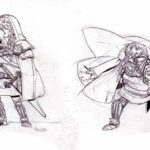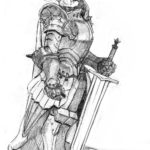First of all, should I assume that by “these kind of things” you mean this site? Uh, okay?
I feel like you missed the whole point of this blog.
You personally prefer bikini armor and find it more interesting than full-covering, realistic one? More power to you! Then again, it’s not about you and your personal preferences.
It’s about pervasive trends of how media depicts women almost exclusively in objectifying ways and offers no alternative to this objectification. Even if said media is supposedly interactive and customizable (video games, especially RPGs of all kinds).
BABD blog is devoted to the fact of how those trends are especially obvious when combat-based female characters are depicted.
I’m not advocating for covering every female warrior from head to toe (if you haven’t noticed), but for some logic and consistency.
You see, there is such thing as Willing Suspension of Disbelief, the untold agreement between the author and the audience that helps to experience immersion in the fiction.
The audience intuitively agrees to overlook unrealistic/fantastic aspects of experienced fiction as long as they make sense in the narrative. It does not mean they uncritically assume everything out of ordinary to be normal.
If the author doesn’t create consistent rules for their world of fiction, the illusion of reality fails and the audience can not suspend their disbelief anymore.
So really, there’s no “It’s just fiction, so don’t expect gritty realism from it” card to play. Again I’m going to refer a reply I reblogged some time ago from simonjadis:
A naturalistic story tells a story that is completely plausible in our world. No wizards, no dragons, no secret vampires, no alien invasions. Telling a realistic story is telling a story that is logical and consistent and makes sense (even if the setting is in a fictional world or in a reality very different from our own).
This is usually the case with skimpy armor. The point of armor is to provide physical barrier, protection from bodily damage in combat.
For instance, a bikini made out of chainmal (or any other armor material) is just a weird (and possibly uncomfortable) bikini, not an armor. It serves the purpose of a bikini (cover nipples and crotch!), not of the amor (protect everything that can be slashed or stabbed!).
So in the setting where people wear armor for the same reason as in the real world, a knight in a metal bikini looks simply ridiculous, and, again, probably can not move without major discomfort.
As for the settings that justify skimpy battle outfit with magic/science/whatever that can create protective barrier… Yeah, makes sense AS LONG AS EVERYONE’S COSTUME IS LIKE THAT. If the same magic armor looks completely regular for guys, but takes form of underwear/bikini/whateverthehellthisis for women, then we face a double standard which can not be justified in-story.
There’s also the issue of skimpy armor supposedly symbolizing empowerment or badassery of a female character.
The thing is, there’s nothing inherently empowering (or sexual, but that’s another story) about partial nudity. There’s a bigger issue of cultural context behind it.
If you stop to think why most half-naked warrior women look like lady on the left, not like one on the right, you’ll understand how female nudity is used to be ogled; not to symbolize power, like male nudity.
Then again, some heroines may be characterized to feel empowered by being sexual (Emma Frost and Bayonetta are most frequently brought up as examples), but the message fails through if everyone around them is designed to look equally sexual, despite having different personality and views on that.
Just like those characters, you personally are completely free to read non-practical costumes in MMOs as attractive/empowering, but those who have different opinion should be given the choice between any level of practicality, especially since character customization is a big part of roleplaying game experience.




